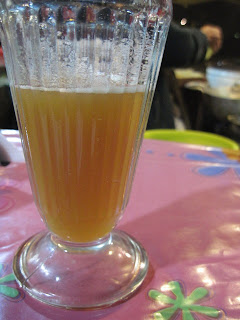Adventures in Eating, part 1
 |
| Dina – street food has been served on this location for 62 years |
Walking the 15 minutes to Dina, Suzanne was not absolutely sure she was going to try the Anticucho or fried cow’s heart, but the smell of it cooking was amazing, and with an appetizer of picarones or mini donuts, even the most skeptical (and queasy stomach) was converted, but not before a sampling of three local drinks.
Local Drinks
First we were served a large pitcher of Chicha Morado, a non-fermented dark purple drink made from Peru’s Black Corn. It tastes similar to Bissap, a drink we had in Ghana that is from Senegal and made with the hibiscus flower, though the color of Chicha Morado is much darker.
 |
| Chicha Morado |
 |
| Chicha de jora |
Picarones or those wonderful fried donuts
 |
| Picarones |
Next were the picarones, or mini fried donuts are made from squash and sweet potatoes and served with a thick sweet syrup that I’m told is a light molasses, but it tastes like honey to me. Each batch of picarones (either petite or grande) is fried fresh while you watch, and consumed while piping hot.
 |
| Picarones – mini fried donuts Delicious! |
And now the Anticucho, or fried cow’s heart which until we were told otherwise, looked like simple beef kebabs served over some fried potatoes. We’ve seen, or rather smelled anticucho being cooked on many of the street corners around Huancayo, but we had been warned not to try any street food as it would make us sick. Challenge Accepted!
 |
| Anticucho |
Now I’ve had kebabs in a number of cities around the world, and, except for the rather chewy Ghanaian beef kebabs, found them to be tasty, quick and cheep eats. Tonight’s offering at Dina was no different. The story goes that the Spanish Conquistadors encountered this dish, but made from llama meat Later it was adapted by African slaves who, during colonial times, were given the cast offs of the cow that the Spanish didn’t want, organs meats such as heart, stomach, (need I go on?).
 |
| Frying the Anticucho |
Until the first bite, the thought of eating anticucho is a bit revolting, but taste wins, and it takes little convincing for Suzanne, who ends up having ore than a bite, and I find myself eating several, and still fighting over the last piece (we end up splitting it, after all we are Christians).


0 Comments:
Post a Comment
<< Home